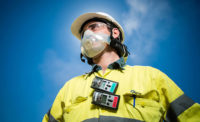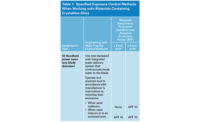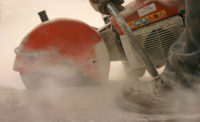In June 2018, OSHA introduced the silica standard so workers exposed to silica-generating tasks would be protected from the hazards of silica and silica dust. Just over a year in, we have seen some companies still failing to comply, others still in the process, and others doing quite well.
Why the OSHA standard and others like it worldwide?
Breathing in very small "respirable" crystalline silica particles causes multiple diseases, including silicosis, an incurable lung disease that leads to disability and death. Respirable crystalline silica also causes lung cancer, chronic obstructive pulmonary disease (COPD), and kidney disease. Silica dust is harmful when inhaled into your lungs -- it is 100 times smaller than a grain of sand; you can easily be breathing it in without knowing.
Crystalline silica is most dangerous to health when dust is generated, becomes airborne and is then inhaled by a worker.
Range of exposures
Examples of work activities that can generate respirable silica dust particles include:
- during fabrication and installation of composite (engineered or manufactured) stone countertops
- excavation, earth moving and drilling plant operations
- clay and stone processing machine operations
- paving and surfacing
- mining, quarrying and mineral ore treating processes
- tunnelling
- construction labouring activities
- brick, concrete or stone cutting; especially using dry methods
- abrasive blasting (blasting agent must not contain greater than one percent of crystalline silica)
- foundry casting
- angle grinding, jack hammering and chiselling of concrete or masonry
- hydraulic fracturing of gas and oil wells, and
- pottery making.
Sequence of compliance steps
OSHA estimates that some two million construction employees are exposed to respirable crystalline silica in more than 600,000 workplaces across the country.
In order to comply with the standard, companies need to:
Identify which specific work tasks may expose an employee to silica dust.
Specific construction activities that may generate silica include:
- Saw cutting and jack hammering of concrete or asphalt
- Cutting and shaping stone
- Excavation work
- Site preparation and clean-up (sweeping)
Evaluate exposure to silica dust. Exposure to respirable crystalline silica can be evaluated one of three ways:
- Referencing Table 1 of the OSHA Respirable Crystalline Silica Standard for Construction*
- Referencing applicable objective exposure data
- Conduct air monitoring- which is the most accurate and valuable to employees
*OSHA has developed a table for construction work that can be found on their website. It lists specific tasks, their required engineering and work practice control methods and respiratory protection procedures.
Develop an exposure control plan for the identified tasks or operations.
Review work tasks and talk to employees about various ways to reduce exposure.
Implement engineering/administrative controls to minimize exposure as needed.
Engineering controls should be considered first and include exhaust ventilation/dust suppression systems as well as vacuums integrated into some power tools. Administrative controls include scheduling maintenance and high-exposure operations when few employees are present, job rotation schedules, and using work scheduling that limits the amount of time employees are exposed.
Determine the need for respiratory protection and/or a medical surveillance program based on exposure evaluation results.
Respiratory protection may be necessary when engineering or work practice controls are not effective in minimizing employees’ exposure to respirable crystalline silica. While engineering controls are ideal, often respiratory protection in conjunction with engineering controls or respiratory protection alone is needed.
Develop and provide employee training.
Companies must review and update their hazard communication training programs to now include silica-specific information, including tasks with potential exposure to silica. Employers now must provide training on how to reduce risk of exposure, and to notify employees of results and corrective actions. Maintaining medical and exposure records are now critical as well.
The cost of not complying
OSHA began enforcing the silica rule in the construction industry in June, 2018. Since then, there have been hundreds of fines issued with the largest identified being more than $300,000 at a single company -- a highway contractor in Virginia. This year, Buffalo New York Zoo that was fined $45,000 for exposing workers to silica dust during demolition work. Fines for violating the silica standard are not trivial as most citations fall under the OSHA serious violation category.
A global concern
Currently approximately 30 of 34 countries surveyed have specific standards but the limits vary country to country. This makes it difficult for companies with operations or projects in multiple countries.
In Canada, the regulations and occupational exposure limits (OELs) that govern silica dust often differ from province to province. Some companies have taken the same route of contractors in the U.S. who do work in different states by complying with the standards of the most strict or rigid province.
Currently, the Australian Exposure Standard for airborne crystalline silica (silica dust) is 0.1mg/m3 over an 8 hour period – this can equate to as little as 15 minutes of cutting or polishing reconstituted or engineered stone without the right safety measures in place. However, it is likely that the Australian Exposure Standard will be cut by 75% to 0.025mg/m3, in line with many other countries around the world.
Additionally, ISHN magazine published a great article in October, 2018 regarding International Exposure Limits for Silica
It’s important to remember that OSHA’s role extends beyond setting and enforcing standards. OSHA also provides training, education and assistance. Everyone’s goal should be to create a safe working environment. If you require more information, visit www.osha.gov and read the OSHA’s Respirable Crystalline Silica Standard for Construction factsheet at https://www.osha.gov/Publications/OSHA3681.pdf.



